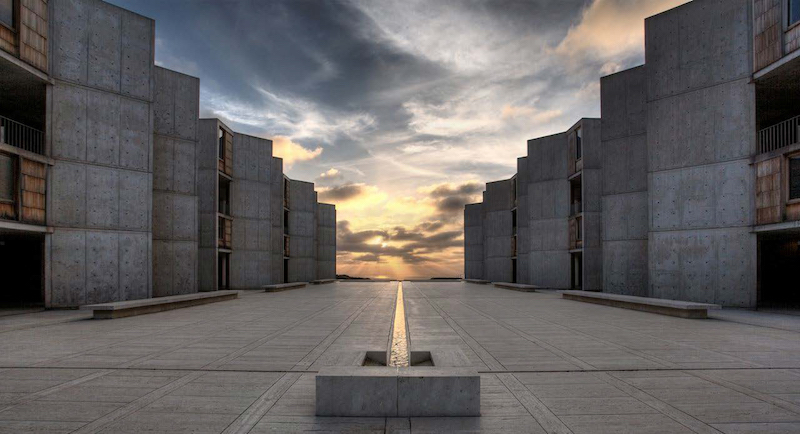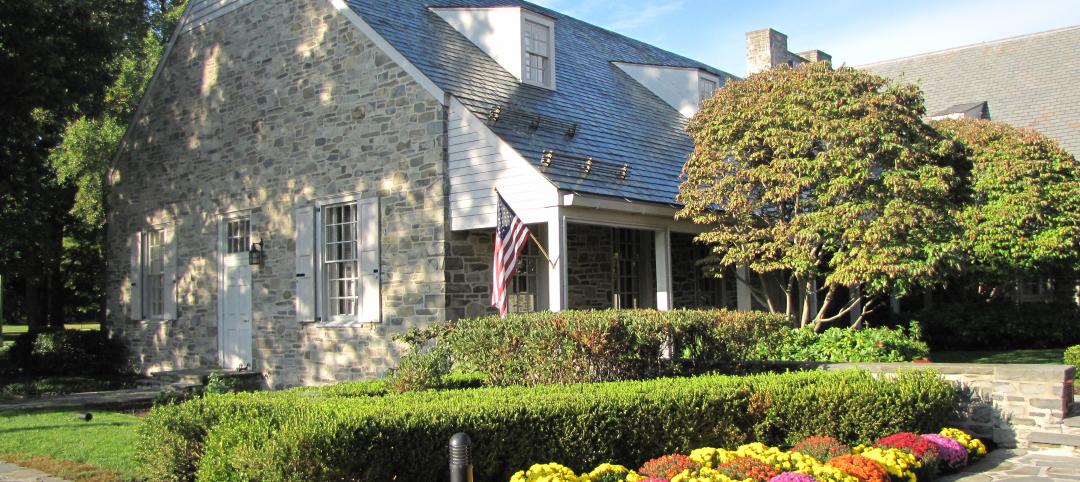After three years of research, the Getty Conservation Institute (GCI) announced construction work is underway to conserve key architectural elements of the Salk Institute for Biological Studies in La Jolla, California. Designed by famed architect Louis Kahn and completed in 1965, the site is widely considered to be a masterpiece of modern architecture.
Dr. Jonas Salk, the developer of the polio vaccine, commissioned Kahn to design the campus for his new scientific research institute on a coastal bluff in La Jolla, just north of San Diego. Kahn worked closely with Salk on the design of the building, which houses laboratories and other research facilities.
But fifty years of exposure in a marine environment has caused the institute’s distinct teak window walls, set within the monolithic concrete walls of the site’s study towers and offices, to weather and deteriorate in a non-uniform manner. The construction work, designed by Wiss, Janney, Elstner Associates, Inc. will address these issues. Getty-led research and funding launched in 2013 as part of the GCI’s Conserving Modern Architecture Initiative (CMAI) helped to initiate the current construction work.
The 203 teak window walls are significant elements of the overall site, expressing a human element and scale within the monumental structure. Although prefabricated, each window has a handcrafted quality due to the detailing of the teak wood by carpenters and customization to fit many sized openings. Each offers a different combination of sliding windows, louvers, and shutters, allowing staff to control light and air in their workspaces.
Research found that the window walls suffered from surface erosion, the growth of a fungal biofilm (likely spread by nearby eucalyptus trees) that gave the wood a black appearance that varied significantly by exposure, changes to teak color due to previously applied sealers and finishes, insect infestation, and moisture infiltration due to the omission of flashings and weather stripping and the failure of sealants.
The GCI and its consultants engaged in historical research, including visits to the Khan archives and collecting oral histories, in order to better understand the significance of the window walls and Kahn’s original vision for the site. It explored the extent of damage to the window walls and performed physical and laboratory analysis to identify materials used and various causes of damage and deterioration. The GCI also convened a meeting of Salk representatives, other Kahn building owners with similar wood conservation issues, and preservation professionals. Possible treatments for the wood and wood replacement options were also researched, as well as design modifications to improve the overall performance of the assemblies. Finally, the GCI, along with the architectural and engineering firm Wiss, Janney, Elstner Associates, Inc. (WJE), which served as the historic preservation consultant to the Salk Institute, developed a series of on-site trial mock-ups to evaluate different repair approaches and treatments to identify the most appropriate ways to move forward.
WJE has developed comprehensive construction documents to implement the repair and conservation of the window walls, with interventions ranging from minor (cleaning and repair), to moderate (cleaning, repair, and some replacement of materials), to major (removal of the entire window assembly where severely deteriorated and replacement using like-for-like materials). At this time, WJE is currently implementing the repair work, which is expected to be completed in 2017.
Related Stories
| Feb 17, 2012
Tremco Inc. headquarters achieves LEED Gold certification
Changes were so extensive that the certification is for new construction and not for renovation; officially, the building is LEED-NC.
| Feb 16, 2012
Summit Design + Build begins build-out for Emmi Solutions in Chicago
The new headquarters will total 20,455 sq. ft. and feature a loft-style space with exposed masonry and mechanical systems, 15 foot clear ceilings, two large rooftop skylights and private offices with full glass partition walls.
| Feb 15, 2012
Englewood Construction announces new projects with Destination Maternity, American Girl
Englewood’s newest project for Wisconsin-based doll retailer American Girl, the company will combine four vacant storefronts into one large 15,000 square-foot retail space for American Girl.
| Feb 14, 2012
SAIC selected for architectural and engineering design services at Lajes Field, Azores
SAIC’s services will include a broad variety of new construction projects and maintenance and repair projects
| Feb 8, 2012
World’s tallest solar PV-installation
The solar array is at the elevation of 737 feet, making the building the tallest in the world with a solar PV-installation on its roof.
| Feb 6, 2012
Kirchhoff-Consigli begins Phase 2 renovations at FDR Presidential Library and Museum
EYP Architecture & Engineering is architect for the $35 million National Archives Administration project.
| Feb 2, 2012
Fire rated glazing helps historic university preserve its past
When the University embarked on its first major addition since the opening of Hutchins Hall in 1933, preserving the Collegiate Gothic-style architecture was of utmost importance.














